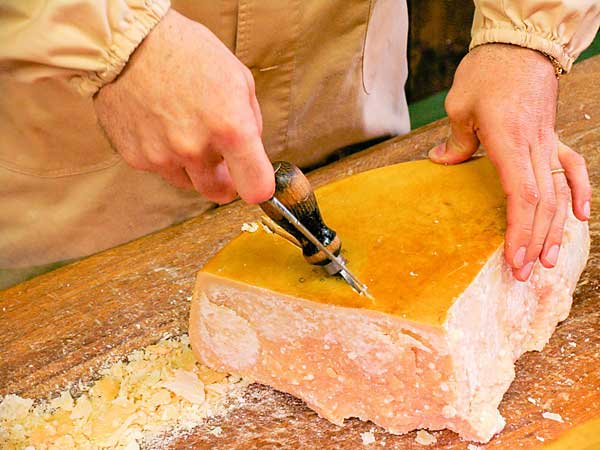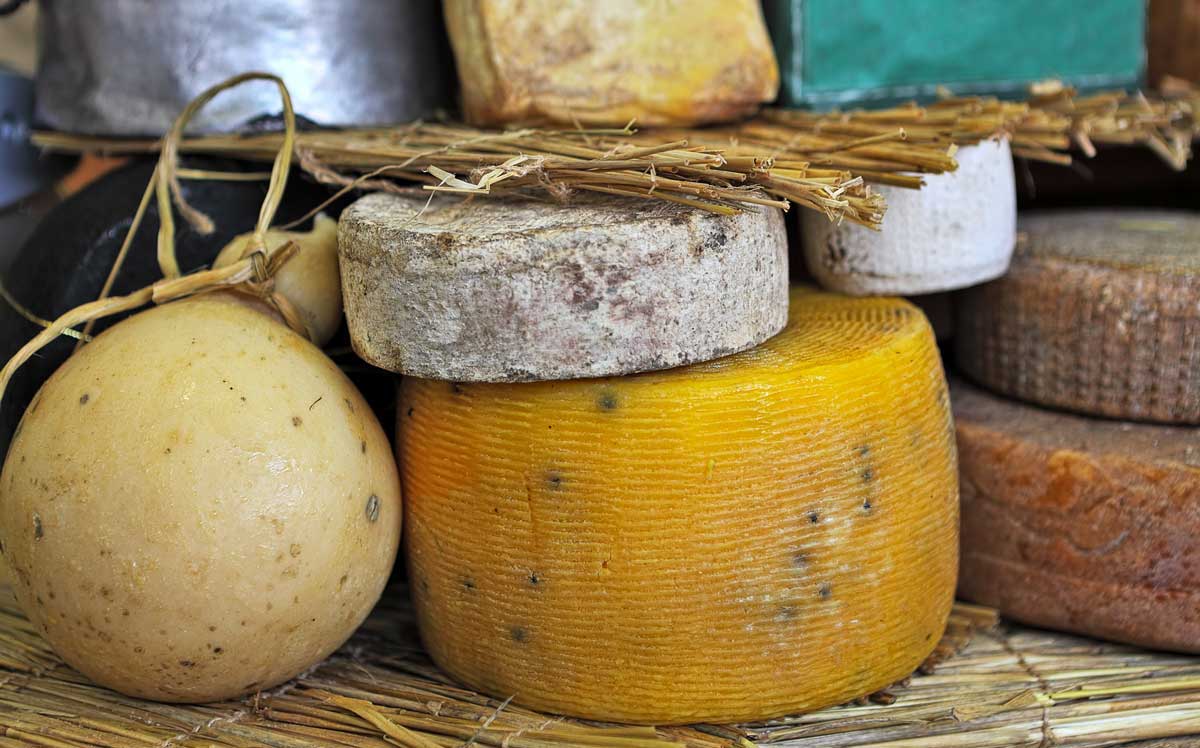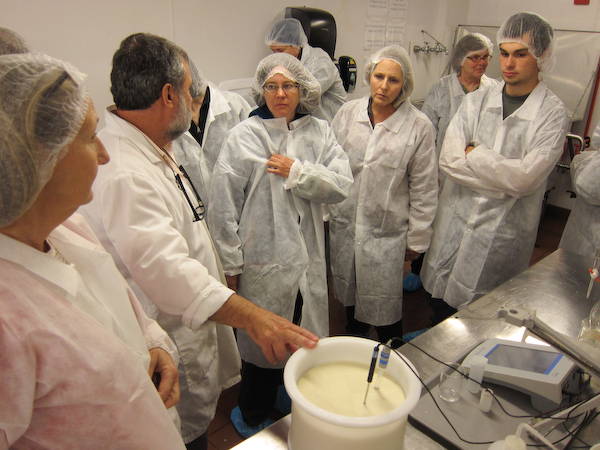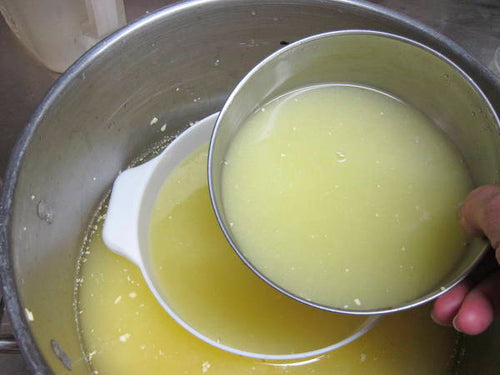Over the past several years I have spent a good deal of time visiting cheese makers around the world in search of the real story behind great cheese. True Parmigiano-Reggiano cheese is controlled with a Protected Designation of Origin (PDO) from the EU applying to a very specific region of Northern Italy. This is overseen by the Consorzio in the Parma region with very strict rules and inspections to maintain the quality of the cheese.
Skimmed Milk
In Italy, the milk is one of the most important aspects of this cheese. The milk producers are paid a premium for this milk and the current trend is to bring back the traditional Vacha Rossa (Red Cow) as opposed to the Holstein types that have been used recently. The milk is always collected immediately following the milking. Even the distances that milk can be hauled are limited by them. On one of my recent visits to a family farm outside of Parma, Julio and his 2 sons would take off each morning and evening heading in 3 different directions to collect the milk fresh from milking.
Parma is not a full fat cheese and the evenings milk is allowed to rest in shallow pans overnight for the cream to rise. The evening's low fat milk is then blended with the morning's full fat milk run directly to the vat. The cream is then made into butter or shipped for other uses.
Fresh Starter Cultures
In addition to the cows' diet, there are different and unique micro flora and yeasts in the milk. The American practice of heating the milk for pasteurization kills these microorganisms. However, since Italians use raw milk to make Parmesan, these microorganisms add unique flavor components to the cheese that can give you extreme highs and lows of flavor. Pasteurized milk gives you a more consistent product, and it saves money for the manufacturer.
The starter culture must be made in each dairy from the previous days whey, which is allowed to ferment overnight. And only rennet from calves is allowed as a coagulant- none of the more modern vegetable or microbial rennet.
It's not just the milk that is different in the United States. Another notable cheese from Italy is Caciotta. This cheese is often enjoyed fresh and is a staple on Italian tables, making it a delightful complement to various dishes. Like Parmigiano-Reggiano, it reflects the unique regional characteristics that define Italian cheeses. Parmigiano-Reggiano has deep roots in Northern Italy. It showcases the unique characteristics of the local milk and is crafted in both the mountains and lowlands, particularly along the Po River valley. In addition to the rich flavors found in Parmigiano-Reggiano, Italy is home to other exceptional cheeses like Crescenza, which showcases the versatility of fresh milk in cheese-making. This cheese, often enjoyed in various culinary applications, reflects the importance of quality milk just as much as its more aged counterparts. American cheese makers often use non-animal rennet to curdle the milk. And the starter cultures differ, with Italians using the whey left from the cheese-making of the day before, while Americans generally purchase starters from enzyme manufacturers. Finally, each cheese maker, and each facility, will have slightly different microorganisms in its environment, which alters the flavor of the cheese being produced.
Parmesan cheese does not contain lactose, as a consequence of the quick development of lactic bacteria which ferment all the lactose present in the curd in about 6-8 hours. Even galactose, which derives from lactose, is quickly metabolized by lactose bacteria and within 24-48 hours disappears completely (the primary reason why the cheese is held for so long before salting).
Copper Vats
These must be copper. The shiny surfaces are not from polishing but from constant use and the acidity of the whey. Officially, the Consorzio holds that copper is used for its superior thermal nature and gives no taste to the cheese. However, the cheese makers insist that copper imparts elements of flavor to the finished cheese. So concerned is the Consorzio with keeping the good name of Parmigiano that it even regulates how many of these heating kettles each certified cheese maker can oversee (a maximum of seven). These certified cheese makers have all studied between ten and fourteen years with a master cheese maker, so obviously the making of this cheese is not something lightly regarded in Italy.
These vats, while only at waist height on the cheese room floor, are tapered to a narrow bottom and about 9 feet deep, going well below the floor level. The shape is much like an inverted bell. The reason for this is that the curd, once cooked, sinks and forms a compact mass at the bottom, simply due to its own weight.
In some other more remote regions, I do find smaller versions of these bell shaped vats in use sometimes with wood fires. They probably go back to a less mechanized time when smaller cheeses were produced. This vat pictured is being used for a Bitto cheese in the mountains above Lake Como.
The Curd Production
Unique to this cheese is a very quick coagulation to a soft curd, a very quick cut to wheat or rice sized curds, and then a very quick scald to 131-133F. I remember the first time I actually timed the scald from 96-133F and how it went against what I had been taught. The key here is that small curd size.
This small curd size and quick cooking are the primary reason for the "Grana" or grain like structure in the finished cheese. It is also the reason why Parma can age for such long periods and result in such a complex cheese.
The curd is cut much earlier than most other cheeses using the tool shown here. It is called a Spino and I am told this refers to the forked stick that may have been used in years past.
Once the curd has been cut to the small grain and cooking begins, a very rapid stirring (usually mechanized as shown) is done. One point that threw my observations off initially is that all temperatures are read in an old Swiss scale of Réaumur (note the "R" on thermometer in the picture below). All of these have been converted to Fahrenheit here to avoid confusion.
Once the curd scald is done, the cheese maker needs to pay special attention to the final state of the curd. This is a very subjective observation made by the experienced cheese maker simply pressing a handful of curds and observing how they consolidate. This will only be achieved by experience.
Once this final texture is determined, the vat stirring is stopped and the curd is allowed to settle into the narrow bottom of the vat for about an hour where the sheer weight of the curd consolidates itself. This curd mass is normally about 180 to 190 lbs for each vat and will later be divided into 2 cheeses.
This step is largely responsible for the 'Grana' or grainy structure so characteristic of this cheese. This is also partially why it is difficult to reproduce the true character in a smaller cheese.
Gathering Curds and Pressing
Bringing this curd mass up from the depths of this deep vat is a performance in itself. The 180 pound mass of curd, aptly referred to as the 'Bambino', has been consolidating under its own weight and needs to be coaxed from the vat to drain in its form. The tool of choice here is a long 10 foot paddle. The cheese maker gently levers the cheese from the bottom to the surface where it is captured in a heavy draining cloth.
The cheese is then worked back and forth in the cloth to smooth out the surface and then hung from a heavy bar to drain while the whey is drained from the vat. The next step is to divide the mass into two separate cheeses.
The forms have been made ready on heavy tables and rolled into place near the vats. The cheese is now ready to be hauled from the vat and into the forms. Not a task for lightweights since these can weigh about 90-100 lbs each.
These forms will now rest for several days during which a Fascia sheet with the identity of the cheese maker and date it was made will mark the cheese surface. These will also embed the words "Parmigiano Reggiano" over the entire surface of the final cheese.
Because of the large mass of these cheeses, very little weight is used. The total added weight is of 26-30 lbs.
Following this long rest, during which the final lactose is consumed, the cheese will then be placed in a long salt bath of up to 20-30 days.
Fresh Whey Ricotta
Following the whey removal from the vats, the whey is heated for Ricotta. Parma is a very good candidate for this and most producers make the ricotta. The remainder of the whey after the ricotta is drawn is pumped for travel to the Famous Parma Pigs. Yes, Parma Ham.
The Final Parmigiano Reggiano
In the end, it all goes to the aging room where it is held for 14 months up to several years. It will be graded and if it passes, it will receive the "Parmigiano Reggiano" stamp literally burnt into its hide. If it fails, the entire surface of the cheese is scored removing all traces of the "Parmigiano Reggiano" embedded into its surface. This cheese is then sold at lower prices for cooking, although it is still a great cheese.
In the end, this is a truly extraordinary cheese, it is never cut, but broken with special knives for prying. This reveals the unique grain-like structure of the cheese.












































































































































